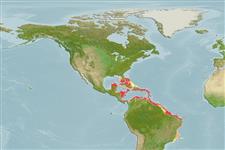Environment: milieu / climate zone / depth range / distribution range
Ecologia
marinhas associadas(os) a recifes; intervalo de profundidade 0 - 85 m (Ref. 9626), usually 5 - 30 m (Ref. 9626). Tropical; 28°N - 25°S, 91°W - 31°W
Western Atlantic: Bahamas to Brazil, including the southern part of the Gulf of Mexico and throughout the Caribbean Sea.
Tamanho / Peso / Idade
Maturity: Lm ? range ? - ? cm
Max length : 37.0 cm TL macho/indeterminado; (Ref. 26340); common length : 30.0 cm TL macho/indeterminado; (Ref. 3815)
Espinhos dorsais (total): 12; Raios dorsais moles (total): 12; Espinhos anais 3; Raios anais moles: 10. Dorsal profile of head moderately steep; prefrontal tubercle not well developed; silvery with a lavender iridescence, the edges of the scales brownish yellow and the centers with a vertically elongate iridescent blue-green or blue spot (Ref. 13442).
Adults often seen over rocky areas or reefs, but also on flat bottoms to about 85 m depth, while the young inhabit shallower waters (Ref. 3815). Feeds on crabs, mollusks, worms, brittle stars and hermit crabs (Ref. 3815). This is the most common species of the genus in the Antilles (Ref. 3815). Important food fish (Ref. 3815).
Life cycle and mating behavior
Maturidade | Reprodução | Desova | Ovos | Fecundidade | Larvas
Cervigón, F., 1993. Los peces marinos de Venezuela. Volume 2. Fundación Científica Los Roques, Caracas,Venezuela. 497 p. (Ref. 9626)
Categoria na Lista Vermelha da IUCN (Ref. 130435)
Ameaça para o homem
Reports of ciguatera poisoning (Ref. 30303)
Utilização humana
Pescarias: espécies comerciais
Mais informação
Nomes comunsSinónimosMetabolismoPredadoresEcotoxicologiaReproduçãoMaturidadeDesovaAgregação para desovaFecundidadeOvosDesenvolvimento dos ovos
ReferênciasAquaculturaPerfil para aquaculturaEstirpesGenéticaElectrophoresesHereditariedadeDoençasProcessamentoNutrientsMass conversion
Ferramentas
Relatórios especiais
Descarregue XML
Fontes da internet
Estimates based on models
Preferred temperature (Ref.
123201): 25.4 - 28, mean 27.3 °C (based on 212 cells).
Phylogenetic diversity index (Ref.
82804): PD
50 = 0.5001 [Uniqueness, from 0.5 = low to 2.0 = high].
Bayesian length-weight: a=0.01950 (0.01248 - 0.03045), b=2.95 (2.82 - 3.08), in cm total length, based on LWR estimates for this species & Genus-body shape (Ref.
93245).
Nível Trófico (Ref.
69278): 3.7 ±0.2 se; based on diet studies.
Resiliência (Ref.
120179): Médio, tempo mínimo de duplicação da população 1,4 - 4,4 anos (Preliminary K or Fecundity.).
Fishing Vulnerability (Ref.
59153): Low to moderate vulnerability (27 of 100).
Nutrients (Ref.
124155): Calcium = 45.5 [21.0, 91.8] mg/100g; Iron = 0.561 [0.298, 1.114] mg/100g; Protein = 19.3 [18.0, 20.7] %; Omega3 = 0.124 [0.075, 0.208] g/100g; Selenium = 33.9 [17.7, 64.2] μg/100g; VitaminA = 58.9 [14.9, 219.9] μg/100g; Zinc = 0.977 [0.631, 1.411] mg/100g (wet weight);
